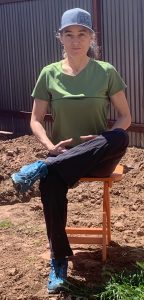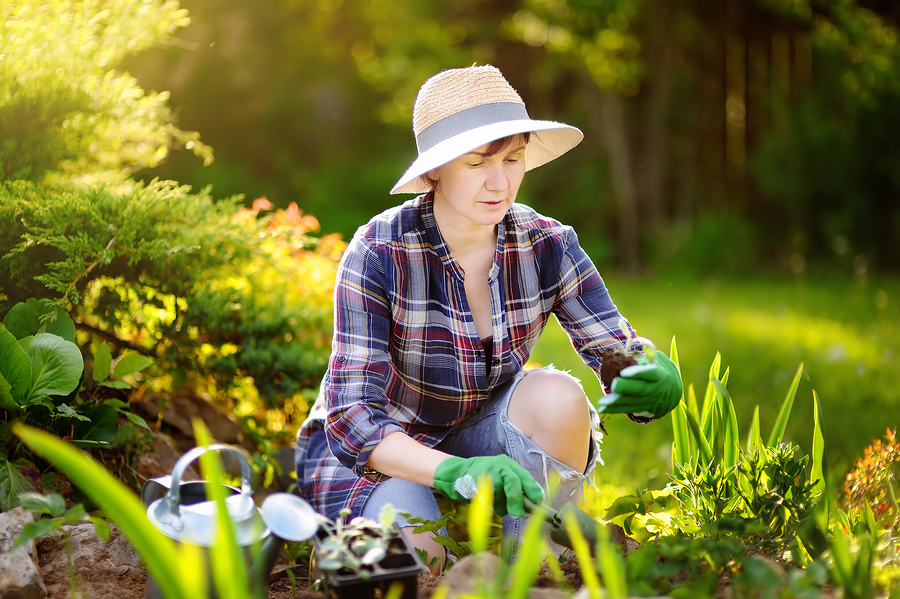Please enjoy this re-print of my article that was published in the May 2019 Moab Happenings.
Spring is here! Now is the time to prepare the soil for your garden! Unfortunately, this can mean spending several hours bent over with your hands in the dirt, pulling weeds and planting. Weeding and gardening can be greatly rewarding tasks because they leading to delicious home-grown food and beautiful flowers. However, the work and postures involved can leave you achy and stiff. In order to remedy this, try breaking up your outdoor work sessions with the following exercises.
1. Standing Cats & Dogs
 Often, while gardening, you are hunched over for a while. As a result, it can be hard to straighten back up. This is because the back muscles feel tight, and they also might feel stuck in place. This first exercise brings movement and blood flow to these overworked tissues. Actually, it is like giving yourself a massage because it takes the spine through a full range of motion.
Often, while gardening, you are hunched over for a while. As a result, it can be hard to straighten back up. This is because the back muscles feel tight, and they also might feel stuck in place. This first exercise brings movement and blood flow to these overworked tissues. Actually, it is like giving yourself a massage because it takes the spine through a full range of motion.
First, stand with your feet hip width apart and pointed straight ahead, with a slight bend in your knees.
The Cat
Next, starting at the pelvis, tuck your tail under and allow your head to drop forward. This movement causes your spine to lengthen from your tailbone to your head. While doing this, move your shoulder blades out and away from your spine. This will create space in your upper back.
 The Dog
The Dog
Once you’ve completed Cat, reverse this movement, again starting at the pelvis. First, roll the front of your pelvis forward so it moves closer to your thighs, forming an arch in your lower back. While doing this, bring your shoulder blades down and together. This will cause you to extend the upper back and open your chest. Finally, lift your head and arch your neck to look up at the sky.
While you are doing this move, you should exhale as you move into the Cat, and then inhale as you go into the Dog. Hold each position for 3 seconds and repeat 10 times.
As a result, your muscles should now feel less tight and more warmed up.
2. Sitting Assisted Hip Lift
Another exercise you can try is the Sitting Assisted Hip Lift. This is a great exercise! Why? Because while you are working in the garden, you are bending and crouching. This results in constant deep hip flexion. The repeated movement can cause the hips to become tight. In order to help this, try this next exercise. It’ll cause the muscles to open in the front and back of the hip joint. In other words, you’ll feel much more relaxed!
 To begin, sit on a chair, step, bucket, or whatever is easily available. At this point, be sure to have a ninety-degree angle between your hips, knees and ankles. Now, place your feet hip-width apart and pointed straight ahead. While here, be mindful that as the seat lowers, the stretch will be more intense. Next, roll your pelvis forward until your sit bones–the bones on the bottom of your pelvis–are both pointing straight down and are equally weighted. As you do this, notice that your lower back should be slightly arched, and your shoulders should be aligned with the hips. Note that this position should feel comfortable without muscular strain.
To begin, sit on a chair, step, bucket, or whatever is easily available. At this point, be sure to have a ninety-degree angle between your hips, knees and ankles. Now, place your feet hip-width apart and pointed straight ahead. While here, be mindful that as the seat lowers, the stretch will be more intense. Next, roll your pelvis forward until your sit bones–the bones on the bottom of your pelvis–are both pointing straight down and are equally weighted. As you do this, notice that your lower back should be slightly arched, and your shoulders should be aligned with the hips. Note that this position should feel comfortable without muscular strain.
Now, cross your opposite ankle over your knee. If you need to, reposition the pelvis so that you regain balance in the sit bones. After you’ve balanced your sit bones, using the muscles around your hips (not your hand), press your knee down toward the ground. (Why no hands? Let me explain. In order to reposition the body, you need to train and strengthen your body in correct posture: hence, no hands. If you simply push your knee down with your hand, you take the body through a passive range of motion without the benefit of strengthening the tissue and repositioning the bones for lasting postural changes.)
Next, lengthen through your spine, and then gently pinch your shoulder blades down and together. Now, hold this position for a minimum of one minute. While you are holding this position, practice deep diaphragmatic breathing into all aspects of your torso—front, back and both sides. When you are done, repeat on the other side.
After going through this process, your hips should feel stretched and opened!
3. Standing Overhead Extension
In addition to the previous exercises, you should try the Standing Overhead Extension. This exercise causes the body to lengthen from head to toe. Here’s how you do it:
To start, stand with your feet hip width apart and pointed straight ahead. While in this position, be sure your knees are straight. However, be sure they are not locked out.
 Next, interlace your fingers and slowly bring them above your head. While you do this, tilt your head back to follow your hands with your eyes. Now, be careful to maintain good alignment with your rib cage and pelvis. Consequently, you will feel your abdominals engage, causing you to hold the correct position. Note: Unfortunately, it is common for the chest to lift, pelvis to roll forward, and lower back to overly arch as the arms raise above the head. However, be sure this doesn’t occur. If it does, you are no longer receiving the benefit of repositioning the upper back and shoulders. Rather, the lumbar spine is compensating to bring the hands farther back. In other words, you are not positioned correctly. Clearly, this is not good!
Next, interlace your fingers and slowly bring them above your head. While you do this, tilt your head back to follow your hands with your eyes. Now, be careful to maintain good alignment with your rib cage and pelvis. Consequently, you will feel your abdominals engage, causing you to hold the correct position. Note: Unfortunately, it is common for the chest to lift, pelvis to roll forward, and lower back to overly arch as the arms raise above the head. However, be sure this doesn’t occur. If it does, you are no longer receiving the benefit of repositioning the upper back and shoulders. Rather, the lumbar spine is compensating to bring the hands farther back. In other words, you are not positioned correctly. Clearly, this is not good!
Now, at the point, keep your elbows straight and close to your ears. While deeply breathing, hold this position for a minimum of one minute. This should cause your body to feel lengthened and realigned!
After my time in the garden, I rest in Static Back or the 90-90 Position to relieve the tension in my body. If you want to learn more about this, read my blog: The Best Position to Relieve Back Pain.
Ultimately, if you do these stretches consistently, they will allow you to work in your garden for many years, pain-free! Thus, I wish you a green thumb and bountiful crops!


